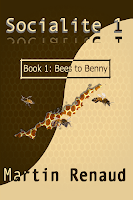Self-published authors have to do everything on their own, including book covers. There are services available, of course, that can be paid to do this. Most of us, however, do not have excess resources so we either do it ourselves, or ask family or friends for help. The DIY approach can also be costly if you do not have graphics software on hand for the task. Photoshop is regarded by most as the best tool for the job, but it is very expensive. For my latest round of book cover designs, I choose to try the free software called GIMP and was pleasantly surprised. Combining Gimp with the Createspace cover template allowed me to overcome the hurdle of creating a cover for my latest book, and editing and redesigning the photoshop generated covers of my previously published books.
First a little history:
Last year I wrote a four book scifi series called Socialite 1. While working on the time consuming task of editing I had little time to work on the covers, so my son (14 years old at the time) offered to do them. He used a combination of tools available on our iMac.
The basic design he used emphasized the dichotomies of good and evil with contrasting dark and light triangles. (here is a picture of the cover of book 1 of the series.) I was very appreciative of his efforts, of course, but knew that I would need to make them more visually appealing at some point in the future. At the time Photoshop was offering a thirty day trial, so I used photoshop to create the back page and spine of the print book covers. I had never used it before, but found it quite easy to learn for this task (using youtube videos as my teacher.)
This fall I completed my fifth book Good Gladys (pictured above) and figured that at the same time as I was designing its cover, I would redo the covers of my Socialite books. I looked for an alternative to Photoshop (because of price) and found that many websites recommended GIMP. I downloaded it (for free!) onto my MAC (the PC version is also available), watched a few youtube HOW-TO videos (here's a sample) and went to work.
I asked my sister-in-law, a wonderful photographer, for a photo depicting a sunrise or sunset—something kind of mysterious looking, appropriate for the murder mystery genre of Good Gladys. She sent this to me (pictured at right). A little cropping and some manipulation of the colours turned that photograph into the cover pictured above. GIMP was really easy to use, and the whole cover took only a few hours from start to finish. For the print version of the book, I just opened the cover template provided by createspace, then added the image of the front that I had created and sized it appropriately. I found that this process was just as easy and effective as it had previously been with photoshop. The resulting pdf document of the cover was instantly accepted by the Createspace editors, just as the photoshop version of the Socialite covers had been.
Here's the final print book cover:
Finally I decided to tackle the socialite covers. The files were Photoshop files (.psd). I was surprised that GIMP had no problem opening these files, preserving all of the layers that I had created in the past. Although I am not very experienced I found the tools in GIMP were fairly easy to use and with some trial and error, I was able to transform that image of book 1 shown above into this:
I highly recommend GIMP. I don't know if really seasoned Photoshop users would experience severe limitations in its functionality, but I do know that inexperienced users, like myself, can get very satisfactory results, with minimal effort. The software is free, and there are many, many instructional videos on youtube to get you started.
To see all of the new book covers for the Socialite series, go to my Good Gladys website and scroll to the bottom. I hope that this was helpful for other self-published authors considering trying their skills at creating interesting, effective book covers.





No comments:
Post a Comment
Thank you for your comments.